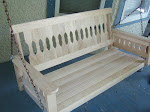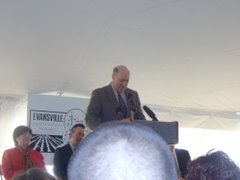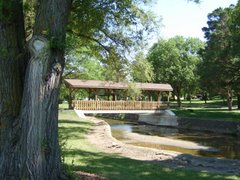Wednesday October 21, 2009
What effect does low frequency sound generated by wind turbines have on people’s living within range of the effects?
This is a difficult question to answer scientifically. The issue is intensely political in nature.
Myself, from curiosity, years ago I set up low frequency loudspeaker driven resonators in my home. There are interesting effects. I expect that at least some of the criticism aimed at wind turbines’ low frequency effects is valid. As a result of my earlier experiments I would sell real estate before it was so affected.
Aerodynamic effects caused by the blades generate wind turbine low frequency noise. The air pressure very close to the blades in the “upstream” or “upwind” direction is higher than the air pressure very close to the blades in the “downstream” or “downwind” direction. The higher pressure on the “front” of the blades combined with the lower pressure on the “back” are what causes the blades to turn. What is happening is exactly the same as an airplane’s wing; the difference in pressure is what makes the wing “lift”. In the wind turbine’s case the blade is so built as to have “lift” in the direction needed to cause the turbine to turn (even though loaded with a power generator) instead of causing flight. As the air spills over and then off of the wing, or over and off the wind turbine blade, the higher pressure air flows into the lower pressure air, causing a rapid increase in air velocity, which is what causes sound. An “eddy” of spinning air is formed, which is continuously being “pulled off” by the moving wing or turning turbine blade, forming downstream vortices. In the case of wind turbine blades (and airplane wings) every effort is taken to reduce waste energy contained in these vortices. The vortices cannot be eliminated but can be made to contain less energy, meaning that the vortices will be relatively less abruptly curved and with less rotational velocity. A decrease in rotational velocity and vortex curvature means a decrease in the frequency of sound emission. We see this in the sound spectra emitted by wind turbines.
So this is where the low frequency sound is coming from. Those who have heard tornadoes note the great intensity of their low frequency sound; same thing is happening here on a much smaller scale.
I suspect many folks are not comfortable with decibels, abbreviated dB. Human hearing has a great range of sensitivity to sound pressure. The least sound pressure detectable by most young ears is 0.00002 newtons per square meter (called a “pascal”). This is 0.000000029 pounds per square inch. It is defined as zero dB sound pressure level. This is a pressure. The power of a sound is proportional the square of the pressure.
The decibel is a logarithmic function. A 10 dB increase means an increase in sound pressure of ten times. Another 10 dB increase means another increase of ten times in sound pressure (and 100 times sound power). One can see that a 20 dB increase is an increase of 10 times 10 times, or an increase of 100 times in sound pressure, and 10,000 times in sound power. Similarly an increase of 30 dB means a sound pressure increase of 1000 times. A sound pressure of 100 dB is then 10x10x10x10x10x10x10x10x10x10, or 10,000,000,000 times. In terms of pounds per square inch, this is 290 pounds per square inch. A loud rock concert (or ear buds maxed out) can measure 110 dB. This is a sound pressure level of 1.5 tons per square inch. Hearing damage ensues. Many car audio installs can hit 120 dB (15 tons per square inch). Shock waves start at 180 dB and work up.
Back to wind turbines, finally!
From the graph I sent you earlier, the representative wind turbine producing a 55 dB(A) noise sound pressure level would produce very low frequency sound of about 100 dB.
This means that the sound pressure caused by very low frequency sound is 45 dB more intense than what is measured using the dB(A) curve. This is the same thing as saying that the sound pressure at very low frequencies is about 40,000 times greater, and therefore 1,600,000,000 more sound power, than what the decibel meter reads when using the dB(A) scale. This means that there is a lot, a lot, of very low frequency sound emitted.
All of this assumes that the measurements were taken correctly so as to allow correction of the measurements to the standard point source at one meter. I am very skeptical about that.
What are the effects of this much very low frequency sound on neighboring human beings? Well, this is a matter of intense political debate; with the pro wind energy people saying such sound is “inaudible”, amongst other things. Certainly I found, in my decades ago experiments, that twenty cycles per second (“Hertz”, hz) at about 80 dB couldn’t be “heard” very well with the ears but had a strong effect on me. Instead of “hearing” with my ears I was “hearing” with my whole body; I remember a deep shaking in the gut and spiders crawling on my skin.
Very low frequency sound goes through house walls like they weren’t there. Even eight inches of concrete isn’t much of a barrier (1 or 2 dB).
Low frequency sound propagation is just now being studied seriously (mostly in Europe, anyone trying this in the USA would never get funding). One thing is well known is that during atmospheric temperature inversions, that is, during times when the air temperature is higher as you go upwards, low frequency sound will be bent, refracted, back toward the ground instead of escaping into the higher atmosphere. In our area we have frequent temperature inversions at night during the winter there is little wind. The ground fog we are so used to is a sign of temperature inversion as the fog is caused by lower air temperatures near the ground than higher up. During these times the homeowner should experience higher very low frequency sound levels and the effects would be noticed over greater distances and a wider area.
Am thinking about buying the tools to do a bit of measurement work in this field. Should be possible to get started with $10,000 maybe.
Wednesday, October 21, 2009
Mailbag; Bear Trader writes on "Low Frequencey Sound and Wind Turbines"
Subscribe to:
Post Comments (Atom)






























This is an excellent explanation of low frequency noise.
ReplyDeleteBear Trader, please consider posting the appropriate portions of this on the Public Service Commission Docket for the Glacier Hills Wind project. http://psc.wi.gov/ click on public comments then look for the Glacier Hills project. To review the existing comments in the case box enter 6603 ce 302.
I have been studying wind turbine noise for close to 3 years. I will list some basic conclusions,
• The low frequency noise produced by wind turbines travels further and with less loss of intensity that the higher frequency sounds.
• Industrial wind turbines produce 105 dB at the hub.
• You don’t need a sound meter or dB reading to tell that a noise is annoying or too loud for you.
• With wind turbine noise it’s more the character of the noise than the quantity in dB that creates the problem.
• Wind developers attempt to defy basic distance attenuation for a line and point source of noise when estimating the impact on humans.
• Estimates of noise are based on one turbine. Two turbines at 50dB equal 53dB add another and it’s 55dB.
• Turbine blade noise is estimated or modeled with the blade perfectly optimized into the wind. In gusty and variable wind conditions the blades can stall creating even more noise.
• Turbines produce more power at night and in a stable atmosphere (inversion) there is no wind at ground level to mask the noise from the blades or nacelle. Typical modeling for turbine noise assumes an 18 mph wind to provide masking.